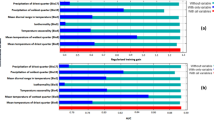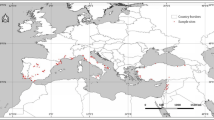Abstract
Models that evaluate the potential geographic distribution of species can be used with a variety of important applications in conservation biology. Osmanthus fragrans has high ornamental, culinary, and medicinal value, and is widely used in landscaping. However, its preferred habitat and the environmental factors that determine its distribution remain largely unknown; the environmental factors that shape its suitability also require analysis. Based on 89 occurrence records and 30 environmental variables, this study constructed Maxent models for current as well as future appropriate habitats for O. fragrans. The results indicate that UV-B seasonality (19.1%), precipitation seasonality (18.8%), annual temperature range (13.1%), and mean diurnal temperature range (12.5%) were the most important factors used for interpreting the environmental demands for this species. Highly appropriate habitats for O. fragrans were mainly distributed in southwestern Jiangsu, southern Anhui, Shanghai, Zhejiang, Fujian, northern Guangdong, Guangxi, southern Hunan, southern Hubei, Sichuan, and Taiwan. Under climate change scenarios, the spatial extent of the area of suitable distribution will decrease, and the distribution center of O. fragrans will shift to the southwest. The results of this study will help land managers to avoid blindly introducing this species into inappropriate habitat while improving O. fragrans yield and quality.




Similar content being viewed by others
Data availability
The datasets used and/or analyzed during the current study are available from the corresponding author on reasonable request.
References
Baskin CC, Baskin JM (2014) Seeds: ecology, biogeography, and evolution of dormancy and germination, 2nd edn. Academic Press, San Diego
Beckmann M, Václavík T, Manceur AM, Šprtová L, Wehrden H, Welk E, Cord AF, (2014) glUV: a global UV-B radiation data set for macroecological studies. Methods Ecol Evol 5: 372-383. https://doi.org/10.1111/2041-210X.12168
Chang MC, Qiu LQ, Green PS (1996) Oleaceae. In: Hong DY, Pan KY, Turland NJ (eds) Flora of China, vol 15. Science Press and Missouri Botanical Garden Press, Beijing and St. Louis
Deb JC, Phinn S, Butt N, McAlpin CA (2017a) Climatic-induced shifts in the distribution of teak (Tectona grandis) in tropical Asia: implications for forest management and planning. Environ Manag 60:422–435. https://doi.org/10.1007/s00267-017-0884-6
Deb JC, Phinn S, Butt N, McAlpin CA (2017b) The impact of climate change on the distribution of two threatened Dipterocarp trees. Ecol Evol 7:2238–2248. https://doi.org/10.1002/ece3.2846
Dong YF (2014) Study on cuttage breeding experiment of Osmanthus fragrans. Sci Farming 5:154–155
Dong Y, Wang X, Zhou G (2014) Recent advances on Osmanthus frangrans seedling cultivation. Sci Plant Cult 5: 12–18.
Elith J, Graham CH, Anderson RP, Dudík M, Ferrier S, Guisan A, Hijmans RJ, Huettmann F, Leathwick JR, Lehmann A, Li J, Lohmann LG, Loiselle BA, Manion G, Moritz C, Nakamura M, Nakazawa Y, Overton JM, Peterson AT, Phillips SJ, Richardson K, Scachetti-Pereira R, Schapire RE, Soberon J, Williams S, Wisz MS, Zimmermann NE (2006) Novel methods improve prediction of species’ distributions from occurrence data. Ecography 29:129–151. https://doi.org/10.1111/j.2006.0906-7590.04596.x@10.1111
Falk W, Mellert KH (2011) Species distribution models as a tool for forest management planning under climate change: risk evaluation of Abies alba in Bavaria. J Veg Sci 22:621–634. https://doi.org/10.1111/j.1654-1103.2011.01294.x
Franklin J (2013) Species distribution models in conservation biogeography: developments and challenges. Divers Distrib 19:1217–1223. https://doi.org/10.1111/ddi.12125
Guisan A, Zimmermann NE (2000) Predictive habitat distribution models in ecology. Ecol Model 135:147–186. https://doi.org/10.1016/S0304-3800(00)00354-9
Guisan A, Thuiller W (2005) Predicting species distribution: offering more than simple habitat models. Ecol Lett 8:993–1009. https://doi.org/10.1111/j.1461-0248.2005.00792.x
Huang SX, Zhou TJ, Luo WH, Wang Y (2007) The method and characteristics of specialized garden construction in Guilin botanical garden. J Guangxi Acad Sci 23:49–52+56
Hijmans RJ, Cameron SE, Parra JL, Jones PG, Jarvis A (2005) Very high resolution interpolated climate surfaces for global land areas. Int J Climatol 25:1965–1978. https://doi.org/10.1002/joc.1276
Larson ER, Olden JD, Usio N (2010) Decoupled conservatism of Grinnellian and Eltonian niches in an invasive arthropod. Ecosphere 1:1–13. https://doi.org/10.1890/ES10-00053.1
Lawler JJ, Shafer SL, White D, Kareiva P, Maurer EP, Blaustein AR, Bartlein PJ (2009) Projected climate-induced faunal change in the western hemisphere. Ecology 90:588–597. https://doi.org/10.1890/08-0823.1
New M, Hulme M, Jones P (1999) Representing twentieth-century space-time climate variability. Part I: development of a 1961-1990 mean monthly terrestrial climatology. J Clim 12:829-856. https://doi.org/10.1175/1520-0442(1999)012<0829:RTCSTC>2.0.CO;2
Phillips SJ, Anderson RP, Schapire RE (2006) Maximum entropy modeling of species geographic distributions. Ecol Model 190:231–259. https://doi.org/10.1016/j.ecolmodel.2005.03.026
Phillips SJ, Dudík M (2008) Modeling of species distributions with Maxent: new extensions and a comprehensive evaluation. Ecography 31:161–175. https://doi.org/10.1111/j.0906-7590.2008.5203.x
Poorter H, Nagel O (2000) The role of biomass allocation in the growth response of plants to different levels of light, CO2, nutrients and water: a quantitative review. Aust J Plant Physiol 27:597–607. https://doi.org/10.1071/PP99173_CO
Stocker TF, Qin D, Plattner GK, Tignor M, Allen SK, Boschung J, Nauels A, Xia Y, Bex V, Midgley PM (2013) Climate change 2013: the physical science basis; contribution of Working Group I to the Fifth Assessment Report. Tech. rep.; Intergovernmental Panel on Climate Change: Cambridge
Stockwell DRB, Noble IR (1992) Induction of sets of rules from animal distribution data: a robust and informative method of data analysis. Math Comput Simul 33:385–390. https://doi.org/10.1016/0378-4754(92)90126-2
Wang X, Yang SG, Yu F, Ji CF, Long CL, Jiang XM (2015) Research progress of Sassafras tzumu. South China Forest Sci 43:29–33
Wu T, Song L, Li W, Wang Z, Zhang H, Xin X, Zhang Y, Zhang L, Li J, Wu F, Liu Y, Zhang F, Shi X, Chu M, Zhang J, Fang Y, Wang F, Lu Y, Liu X, Wei M, Liu Q, Zhou W, Dong M, Zhao Q, Ji J, Li L, Zhou M (2014) An overview of BCC climate system model development and application for climate change studies. J Meteorol Res 28:34–56. https://doi.org/10.1007/s13351-014-3041-7
Yang KM (2013) Chinese Osmanthus. China Forestry Publishing, Beijing
Yi YJ, Cheng X, Yang ZF, Zhang SH (2016) Maxent modeling for predicting the potential distribution of endangered medicinal plant (H. riparia Lour.) in Yunnan, China. Ecol Eng 92:260–269. https://doi.org/10.1016/j.ecoleng.2016.04.010
Zhang K, Liu H, Pan H, Shi W, Zhao Y, Li S, Liu J, Tao J (2020) Shifts in potential geographical distribution of Pterocarya stenoptera under climate change scenarios in China. Ecol Evol 10:4828–4837. https://doi.org/10.1002/ece3.6236
Zhang K, Yao L, Meng J, Tao J (2018) Maxent modeling for predicting the potential geographical distribution of two peony species under climate change. Sci Total Environ 634:1326–1334. https://doi.org/10.1016/j.scitotenv.2018.04.112
Zhang K, Zhang Y, Tao J (2019) Predicting the potential distribution of Paeonia veitchii (Paeoniaceae) in China by incorporating climate change into a Maxent model. Forests 10:190. https://doi.org/10.3390/f10020190
Funding
This work was supported by the Forestry Science and Technology Promotion and Demonstration Fund of Central Finance (Grant No. [2018]TG08); and the Construction of Jiangsu Modern Agricultural Industry Technology System (Grant No. JATS [2019]448).
Author information
Authors and Affiliations
Contributions
All authors contributed to the study conception and design. Material preparation, data collection, and analysis were performed by Fen Kong Liang Tang, Huan He, and Fuxia Yang. The first draft of the manuscript was written by Jun Tao and Weicheng Wang, and all authors commented on previous versions of the manuscript. All authors read and approved the final manuscript.
Corresponding authors
Ethics declarations
Ethics approval and consent to participate
Not applicable.
Consent for publication
Not applicable.
Competing interests
The authors declare no competing interests.
Additional information
Responsible Editor: Philippe Garrigues
Publisher’s note
Springer Nature remains neutral with regard to jurisdictional claims in published maps and institutional affiliations.
Rights and permissions
About this article
Cite this article
Kong, F., Tang, L., He, H. et al. Assessing the impact of climate change on the distribution of Osmanthus fragrans using Maxent. Environ Sci Pollut Res 28, 34655–34663 (2021). https://doi.org/10.1007/s11356-021-13121-3
Received:
Accepted:
Published:
Issue Date:
DOI: https://doi.org/10.1007/s11356-021-13121-3




